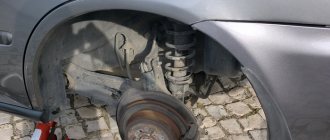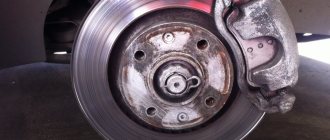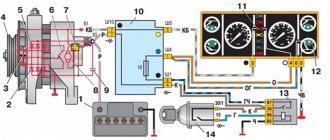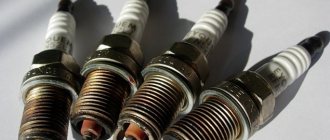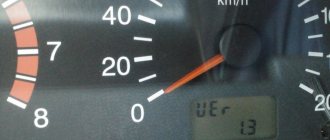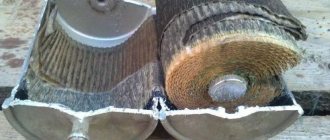It is not always possible to tell by the nature of the vibration where exactly the problem lies. On different cars, only the steering column can vibrate, putting it in the driver’s hands, but the entire body can shake. It all depends on the design, nature and degree of damage to the components and assemblies that need to be replaced. Let's look at the main causes of vibration during overclocking.
We study wheels and chassis - the main cause of vibrations
The main indicator that the wheels or drives of these same wheels are to blame for your problems is shaking at a certain speed. Often these are body vibrations in the range of 80-100 kilometers per hour, but sometimes the shaking may not go away even after 60 km/h, so in any case you need to fully diagnose the chassis.
In this case, it is not necessary to go to a service station and carry out expensive diagnostic operations. It is enough to apply all your knowledge and study each chassis unit for possible breakdown. The most common problems in this case are the following:
- the wheel mounts are unscrewed, which causes vibration on one of the wheels;
- The brake disc is poorly fixed; at speed it begins to vibrate;
- the wheel drive shaft is bent - the body vibrates constantly, with increasing speed the vibration intensifies;
- damaged CV joints - this is the most common problem that causes vibrations on the body;
- The wheel bearings are damaged, which causes shaking at any speed.
The most common problem in this manifestation is CV joints. To check their serviceability, just grab the shaft with your hand and try to turn it. If the shaft has play of more than a couple of millimeters, the CV joint must be replaced. Interestingly, vibrations of the car body during acceleration can be caused by both external and internal CV joints.
You can also easily determine if there is a problem with this chassis mechanism by examining the anthers. If the rubber part of the boot ruptures, we can safely talk about problems with this mechanism. If water, dust and dirt get into the CV joint, the unit will not survive more than a few days.
Steering wheel shaking when driving at speed
The most common shaking that occurs in a car is the vibration of the steering wheel when driving at speed. It is noteworthy that such shaking of the steering wheel becomes even greater when accelerating. As a rule, the vibration on the steering wheel is barely noticeable at first, but then becomes more and more severe. Be aware that vibration in the steering wheel can cause serious damage that can lead to an accident due to loss of control.
Also, if you do not pay attention to steering wheel vibration, this can subsequently lead to rapid wear of many vehicle components (from tires to transmission).
Therefore, if there is vibration in the steering wheel in your car, you must check the following elements of the car:
—
Check wheel balancing. Contact a tire shop to check wheel balancing. Unbalanced wheels can cause strong vibration in the steering wheel at speed. This is the simplest cause of steering wheel wobble, which can be eliminated without much expense.
— Replace shock absorbers or struts . Worn struts or shock absorbers can cause the suspension to perform unevenly, causing the vehicle to shake. Shaking will be especially noticeable on uneven roads or at high speed.
— Check the strut support bearing . They are located on top of the shock absorbers. From the front you can check them under the hood. If they are worn out, replace these components, which may cause vibration when driving at speed.
— Check and, if necessary, replace ball joints . Ball joints often become unusable due to uneven and bad roads. In our country, ball joints last much less than on cars used in Europe. If these components have play, then when moving, this often leads to shaking in the car.
— Check and replace tie rod ends . Steering ends begin to “loose” over time due to wear. Thanks to them, your wheels turn parallel. If the steering lugs are worn out, the front wheels may not be parallel, which will cause shaking (vibration) in the steering wheel.
Wheel alignment and tire quality are another reason for shaking
If the wheel alignment angle is incorrect, vibration, the car pulling to the side, uneven eating of rubber and other unpleasant manifestations are possible. In different models, these problems manifest themselves in different aspects. Adjusting the wheel alignment angles is one of the first processes that needs to be performed after detecting such a nuisance as body vibration.
Problems can also be caused by tires that are worn incorrectly, or a disc after a serious impact. The main processes that can be taken to eliminate body vibration in this case are as follows:
- adjusting the wheel alignment angle at a wheel alignment station;
- replacing tires if there are visual indicators of uneven or excessive wear;
- replacing or repairing a disc that shows dents and uneven rims;
- performing wheel balancing - often during operation the balancing weights fly off.
If the balancing weights have come off the wheel, this may well cause vibrations at speeds of 80 kilometers per hour. The problem is that it is simply impossible to determine this yourself and find out which wheel needs to be sent for balancing. Therefore, you will have to go to a tire shop and have all the wheels of your car balanced.
This is one of the most inexpensive and safest options for breakdowns due to vibration of the body or steering wheel during acceleration. Therefore, the first thing you need to do is check for the presence of such faults, and then transfer suspicions to other options.
Worn or warped brake discs
These elements are installed on the hub and are clamped by pads when the speed decreases. There is practically no gap between the disc and pads. Therefore, the surface of the assembly must be perfectly flat. The slightest distortion of the disc causes the steering wheel to vibrate at speeds of 90-100 km/h. Warping of brake elements most often occurs due to frequent and intense braking, as well as when driving through deep puddles. The heated disk bends due to sudden cooling. This element cannot be repaired - only replaced.
Engine mounts, tie rods and other problems
There is another group of problems that cause vibrations when accelerating a car. It is difficult to collect these problems into one bundle, because they are all different and arise for various reasons. Vibration often occurs when one of the engine mounts is broken. This can easily be checked by increasing the speed while shaking.
The gearbox may also be the culprit for this type of problem. If the car starts to shake at 80 kilometers per hour, you can very easily check the fault of the gearbox by performing the following procedures:
- accelerate to a speed of about 85 kilometers per hour;
- depress the clutch and observe the vibration change;
- engage third gear and smoothly release the clutch;
- try accelerating from 50-55 kilometers per hour in last gear.
If the nature of the shaking does not change in all these experiments, the box has nothing to do with this problem. If there is more shaking when the gearbox is engaged, you will have to check whether it is involved in this problem.
You can also check the automatic transmission. At a speed of about 85-90 kilometers per hour, it is enough to switch the gearbox selector to modes 3, 2, D, N and observe the operation of the box itself and the change in vibrations. Often the gearbox is not to blame for the vibration of the car body, but there are such cases.
The car shakes at idle
If your car shakes when you are stopped at a traffic light, then most likely something has gone wrong. To determine the cause of idle vibration, check the following:
— Broken or worn engine mounts . Broken or severely worn powertrain mounts do not support your engine properly, causing detonation from the engine to be transferred to the body.
— Problems in the fuel system . If the engine speed suddenly drops or increases, it may cause the vehicle to shake or vibrate. In order to find the cause, it is necessary to fully diagnose, using special equipment, the operation of the entire fuel system, starting from various electronic sensors and ending with the fuel pump.
Let's sum it up
If you are unable to find the problem that is causing the body or steering wheel to vibrate in your car when accelerating, you should contact a professional. Do not leave this problem, because it can worsen and create dangerous travel conditions for the driver and passengers of the car. It is necessary to respond as quickly as possible to all possible problems and eliminate them by replacing failed machine elements.
Often, to determine the problem, you don’t even have to go to a service station and use expensive diagnostics. It is enough to inspect the car yourself and determine what problems caused the body vibrations.
Source:www.avto-flot.ru
Categories of products that may be of interest to you based on the article “There is vibration during acceleration: the main causes of the problem”:
The car shakes when accelerating
Vibration or shaking when accelerating a car can cause the most unpleasant sensations of discomfort in a car. The worst thing is when you count on rapid acceleration of the car (for example, to overtake a car), but when you press the gas pedal, you get in response, uneven acceleration with jerks.
In order to find out why the car shakes during acceleration, you need to check the following:
— Low oil level in the gearbox . Yes, a low level of transmission fluid can cause vibration and dips in the acceleration dynamics of the car when accelerating. Including, as a rule, when the oil level in the transmission is insufficient, jerks are observed during acceleration.
— The gearbox filter is clogged . A dirty automatic transmission filter can lead to vibration when accelerating the car. Replace the filter element with a new one yourself or at a car repair shop.
— Wear of the cardan joint . The U-joint on your driveshaft may wear out, causing it to shake or vibrate when you drive or pull away. This is especially obvious when accelerating a car. If the cause of the vibration is really the cardan joint, then do not delay replacing the part, because in the event of a complete breakdown, your car will not be able to move, which threatens with unnecessary expenses for evacuating the car to a car service center.
There can be a huge number of possible problems with a car, and a specific breakdown does not always give specific signs of its presence. Drivers often complain about body shaking when accelerating or at a certain speed. There can be quite a lot of problems that determine this indicator. If your car has vibration during acceleration, you should look at all possible breakdowns and immediately replace the failed components.
Spare parts, maintenance
Products from the Dustershop77 range that may be of interest to you:
| Name | Manufacturer | Price | Availability | Add to cart |
| BR-001-GARD-URDP | Mud flaps enlarged (widened) Duster-GARD front | Duster-Guard | 1500 / 1200 rub. Discount: 1000 rub. | >10 |
| DC495 | Discount card (Dusterclubs.ru, Dustershop77.ru) | 700 / 500 rub. Discount: 500 rub. | >10 | |
| DC218 | Air deflector “Warm feet” for Duster, Logan, Sandero, Largus | 900 / 350 rub. Discount: 250 rub. | >10 | |
| DC654 | Frill with fastening without 3M tape (Duster/Terrano) (ArtForm) | ArtForm (Yuago) | 3000 / 2000 rub. Discount: 1600 rub. | >10 |
| PT014-RDU112901 | Trunk sill trim PTGroup | Pt GROUP | 1200 / 1000 rub. Discount: 900 rub. | >10 |
| 005-008502 | Trunk sill protection | Russian Artel | 1400 / 1100 rub. Discount: 1000 rub. | >10 |
| DG-006-GARD-RDSHCH | Front diffusers - aerodynamic flaps Renault Duster (set of 2 pieces) | Duster-Guard | 700 / 600 rub. Discount: 500 rub. | >10 |
| DC1024-V117 | Windshield and roof edge seal | Duster-Guard | 700 / 500 rub. Discount: 300 rub. | >10 |
| R12711 | Wind deflectors (window deflectors) COBRA/Autoplex | COBRA/Autoplex | 2000 / 1600 rub. Discount: 1500 rub. | >10 |
| NRD-009102 | Frill under the windshield (RA) | Russian Artel | 2500 / 2100 rub. Discount: 1800 rub. | 5 |



